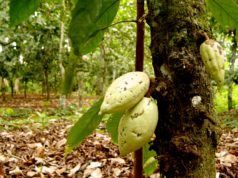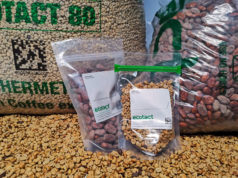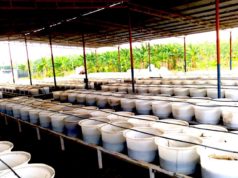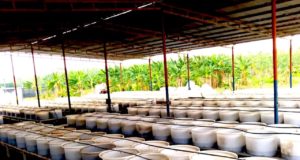By Liliana Elías
The use of machinery and equipment to maximize the efficiency in agricultural activities have long been in our country, crops such as cereals like rice and corn are the most representative in the use of large machinery and equipment. Bulldozers, combined harvesters, sprinklers hitched to a tractor, and even fumigation and sowing using small airplanes are common when it comes to planting in large tracts of this type of monoculture.
Nevertheless, as there has been a wide technological display for the cultivation of some crops, others seem to have left out the usage of new equipment and machinery to allow the improvement of efficiency in agronomic practices.

Cocoa, a field of traditional cultivation
Historically, cocoa has been associated with a significant use and exploitation of the labour force from men and women. It is not a secret that cocoa farms were founded with the slavery labour from various parts of the Africa. The slaves’ ability to adapt, their innate strength and resistance determined a clear preference to use them when it came to hard work, even well above the indigenes living in these areas before the Conquest.
All activities related to the production of cocoa from planting, maintenance, harvesting, fermentation and drying inherently imply a high manual component, no wonder why even today the best allies of cocoa producers are the machete and the garabato, the chícora and the basket or the can, with these simple but very useful tools from the time when the great haciendas were established to the present day, the cocoa producers work their smallholdings and produce the best grain in the world.
When we ask about Andrés Herrera, a cocoa producer from the community of Panaquire, in Barlovento, on the traditional usage of these tools, he says: “Give me a comb and I’ll make you a plot, give me a chícora or a shovel and I’ll make you a hacienda “. So important are these tools in the middle of 21st century for the average producer.

Cocoa is slowly becoming more technical
Until very recently, when someone visited a cacao plantation being worked on, the only thing that happened to be heard was the noise of the comb or the machete cutting the bush. It was also seen a producer with a rod and a harvesting hook, taking off branches or buds from an old plant or cutting a bromeliad growing on a cocoa plant. Today, on the contrary, we hear at a distance a turned on engine, probably a weed whacker or an electric saw being operated by the cocoa producer, his son or a hired labourer who does the work that used to be done by hand, a comb and an axe.
Since today, a very high percentage of cocoa producers have adopted the use of various equipment to improving the efficiency of their work and, on the other hand contribute to maintain their occupational health by reducing injuries caused by many years of work in very difficult conditions.
The cocoa producer Claudio Palacios, from the community of Urba, in Barlovento, told us: “Before my father, Modesto Palacios, worked with a machete and an axe. Property owners came to look for him to the house because he performed an excellent handling the machete task, from very early in the morning until the afternoon. I do not handle machete on my side since I learned how to handle a weed whacker and bought mine one. “
Efficiency at work
Clearing the weeds in cocoa is a key activity for producers in all areas of the country. This work done at least 4 times a year is very important for an adequate maintenance of cocoa crops. Using a weed whacker the working time is reduced substantially, thus, efficiency increases.
Eng. Francisco Betancourt, head of the Agricultural Management Unit of Chocolates El Rey, C.A. tells us that they have reckoned the performance of an experienced operator doing the weed removal, and he mentions that during a day work of 8 hours with a weed whacker, it is equivalent to 5 labourers work in the same time. It means that efficiency is quintuplicated, which represents a cost reduction and also impacts labour time at a medium term, having the possibility of producing more cultivatable land.
On the other hand, today there is another important element on the day-to-day management of cocoa plantations: the extensible telescopic chainsaw. This is used for the restoration of old cocoa plantations that have grown inadequately and excessively. This equipment is utilised to reduce the tree height and adapt its growth and symmetry, which contributes to an important increase in the production since it improves not only the tree shape, but also the micro environment of the cocoa crop providing it adequate light and aeration.
“Until very recently cocoa producers had to climb cacao trees with ladders or simply climb on the plant to prune them. There are not a few stories of producers injured by falling or by a branch bump while doing this work. Therefore, a crew of hedgers composed of two telescopic chainsaw operators and two machete pickers are able to restore one hectare of cocoa (an average of 1,000 trees) in four or five days, depending on how neglected the trees are while using machetes and axes, the work could take up to three weeks or a month” Eng.Betancourt says..
Costs and Availability
Until not long ago, any hardware store in a village offered very good quality equipment at really affordable prices. However, today the reality is completely different, since the prices of weed whackers and chainsaws have been increased considerably and their availability has been reduced either in numbers and brands. Nevertheless, many cocoa producers who want to gain labour efficiency, time reduction and increase the productive land look for some options to acquire them.
An advice
When buying a weed whacker or an extensible chainsaw, it is necessary to buy known brands. In this type of equipment the brand is very important as it has an effect on their durability, technical service availability and the access to spare parts.
What’s more, it is important that the operator knows how to properly handle the equipment for its own safety as well as its maintenance. Likewise, It must be considered that continuous maintenance must be performed in order to ensure its good operation for a long period, keeping in mind that it is an important investment.
And then, what do you prefer? Done by hand or by motor?








